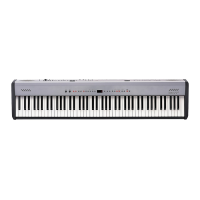47
Chapter 4 Other Functions
What is a Sequencer?
A sequencer is a device that records the stream of MIDI
messages that is sent out by an instrument. These messages
convey all the details of what has occurred while the
instrument is played; including the timing of notes, their
sound, the force used to play them, and for how long.
Afterwards, you can send the recorded MIDI information
back to the instrument, and it will play automatically.
What is a MIDI Sound Module?
Inside a synthesizer or electronic piano is the section that
actually produces sound, known as the sound module. A
MIDI sound module produces sounds as the result of MIDI
messages sent to it by other devices.
■
MIDI Settings
MIDI Send Channel Settings
Select the transmission channel of FP-2.
MIDI features sixteen MIDI channels, numbered 1–16.
Simply connecting a cable is not enough for communication
to take place. The connected devices must be set to use the
same MIDI channels. Otherwise, no sound will be produced,
and no sounds can be selected.
When the instrument is turned on, this is set to Channel “1.”
The FP-2 receives messages on all channels, 1–16.
* When the keyboard is in dual play, the channel you’ve set here
is transmitted.
* When the keyboard is split into left and right sides, the
transmission channel for messages from the left-hand side is
fixed at “3.”
1.
Switch to Function mode(p. 38), and press the
[Rec] button.
2.
Hold down the [Rec] button, and press the [-] or
[+] button so “Ch” is displayed.
fig.04-11
3.
Press the [-] or [+] button to select the
transmission channel.
Select the transmission channel (1–16) of the FP-2.
Switching Local Control On and Off
When connecting a MIDI sequencer, set Local Control to “Off.”
When the instrument is turned on, this is set to “On.”
As illustrated, information describing what has been played
on the keyboard is passed to the internal sound generator
over two different routes, (1) and (2). As a result, you hear
overlapping or intermittent sounds. To prevent this from
happening, route (1) must be severed, by setting the unit to
what is known as “Local Off.”
fig.04-12.e
Local Control ON: The keyboard and the internal sound
generator are in a linked state.
fig.04-13.e
Local Control OFF: The keyboard and the internal sound
generator are in an unlinked state. No sound will be
produced by the keyboard when it is played.
fig.04-14.e
* When connecting a unit in the Roland MT series, you don’t
need to switch off Local Control. MT units transmit Local Off
messages when their power is switched on. If you first switch
on the FP-2, then the MT-series device, Local Control is
automatically switched off on the FP-2.
Press
While holding
down...
(1)
MIDI
MIDI
MIDI
MIDI
(2)
IN
IN
OUT
OUT
Sequencer
Memory
Sound
Generator
Each note played
is sounded twice
Thru function On
Local On
Local On
Sound is emitted
Sound Generator
Local Off
No sound produced
Sound Generator
FP-2_e.book 47 ページ 2004年11月26日 金曜日 午後4時25分

